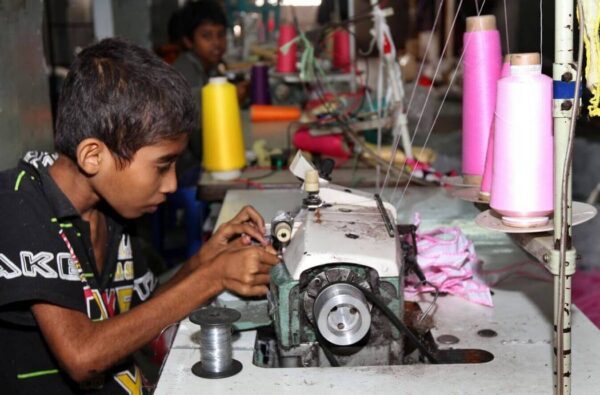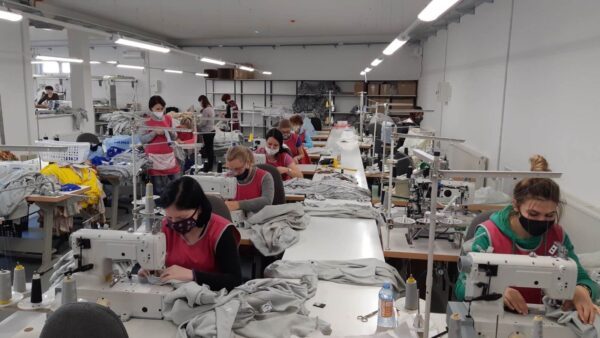The on-demand clothing manufacturing model is something that can reshape the textile industry completely. Mostly in terms of reduced waste and a more fair relationship with the supply chain. But also in terms of return on investment. Let’s see how.
We’ve all witnessed just how horribly the major clothing brands treated their supply chains throughout 2020. Inhumane requests ranged from requesting ridiculous discounts for the ordered goods that were ready to be shipped to downright refusing to pay.
Aside from obvious avarice and blatant disregard for fellow human beings on major brands’ part, something else played a role in this terrible outcome for the garment workers – the traditional wholesale manufacturing model.
The folly of the traditional manufacturing model
This is how most of the textile industry still functions but it’s especially relevant for fast fashion. A fast fashion brand, in order to make a profit from extremely cheap clothes, demands an extremely low manufacturing price from its supply chain. In return, the supply chain representative demands a very high order quantity that will enable him/her to pay the extremely low wage to their workers.
Because of huge orders, oftentimes seasonal workers will be employed, which can be detrimental to product quality. And that’s the least extreme downside to seasonal work in the textile industry.

Seasonal workers are often children. Let that sink in.
This manufacturing model usually creates a lot of dead stock, destined for landfills or incineration. Not to mention that this approach is one of the key reasons that most garment workers live in poverty. So what’s the alternative?
Manufacture on-demand clothing – the more sustainable model
Even though this model is by no measure a guarantee that garment workers will be better off immediately, it’s a move in the right direction. And not only on the ethical front. The business front comes with benefits too. Here’s why.
On-demand clothing manufacturing focuses on smaller batches and a very high level of customization. Basically, when doing business this way, clothing manufacturers would accept MOQs as low as 500 pieces per design. They would also work off the tech pack provided by their client(s). Which means no generic white-label products. But probably the major selling point from the brand owners’ perspective is the fact that it takes significantly less time for them to start selling their products.
On the other hand, manufacturers don’t have to hire seasonal workers and save on materials because the arranged price allows for better-paid workers and higher-quality fabrics.

Sewing professionals at a FUSH˚ clothing factory in Serbia.
It’s only natural when a manufacturing model entails a great deal of customization, that it will come at a higher price for everyone. The end-user, clothing brand, factory owner (trickier pieces demand a more skilled workforce that costs more). However, it takes less time, energy, workforce, and fabrics to be carried out.
Also, it takes a lot of guesswork out of the equation for everyone included simply because there’s not as much warehousing involved therefore less chance of dead stock.
Can FUSH˚ manufacture on-demand clothing?
Yes, absolutely. In fact, our workflow is designed to fit this manufacturing method. Some of it is down to the type of clients we worked with over the years – marathons and various sporting events and teams that all required a great level of customization for their clothing, especially the t-shirts and oftentimes small batches.
And when we branched out to other types of clothes – custom hoodies and other casual wear and streetwear, it was easy to stick to this model and adapt to the emerging trend that is on-demand clothing.
So here’s what we’re accustomed to when it comes to on-demand clothing manufacture:
- Short deadlines for samples (10-21 days)
- Working off from tech packs
- Customizing fabrics (especially the fabrics for activewear )
- Custom grading
- Factory visits (allows our clients to make a lot of useful footage for their marketing campaigns)
There’s also a virtual tour we invite you to go to and see how our clothing factory in south-eastern Serbia looks and works.
There are five conditions to our potential cooperation, though:
- Our MOQ is 500 pieces per design or colour
- If you want us to embroider or print a logo or any design, you must send a vector file with precise positioning on the garment
- You’d have to have a registered company with valid VAT and EORI numbers
- Sampling is mandatory and we charge it 100% in advance and each sample costs €100
- We don’t reimburse sampling from the bulk order price
Learn more about working with us – visit the what we do page.
Find out more about working with us under the made-to-order model, fill out the form below and we’ll get back to you ASAP.
FAQ
What is on-demand clothing manufacturing?
On-demand clothing manufacturing is a process of making clothes after they’ve been ordered by a customer. Some brands set up their operation almost like a dropshipping model, where their customers expect their orders to arrive in two weeks or longer. This is extremely costly because manufacturers lose the most on stopping and restarting production, which is reflected in the price of the final product. Some brands consider on-demand a relationship with their manufacturer where there’s no contract obligation to order a certain number of pieces in a year/quarter/month.
What are the benefits of on-demand clothing manufacturing?
- Reduced waste
- Improved quality
- Faster turnaround times
- Better flexibility
Mass production creates deadstock both in the manufacturers’ warehouses and brands’ warehouses. Textile waste is a serious issue of this manufacturing model. On demand doesn’t have that issue because smaller batches very often manage to sell out.
Because of variety is the reason small brands often opt out for on-demand manufacturing, this process requires adaptable textile professionals that can make various different textile products on limited machinery and in limited time. This improves the quality of the finished garments.
Because the batches are significantly smaller than for mass production, turnaround times are much faster. Even if it’s a complicated order, making 500 pieces vs making 50k pieces will always have a faster turnaround time.
What are the challenges of on-demand clothing manufacturing?
- Higher costs
- Lower margins
- Risk of stockout
Since it requires more specialized equipment and seasoned textile professionals to handle production, on demand costs more. Also, the costs of stopping and restarting production after small batches is costly in itself.
Both the manufacturer and the brand owner would have lower margins with this manufacturing model because it’s not scalable.
Since on-demand clothing manufacturing is synonymous with low MOQ, the realistic risk of a brand selling out its stock is entirely possible.
Request a quote from us
To get the best possible price and lead time estimate, please include the number of designs and pieces per design, fabric choice, sizes, and printing options.
- FUSH˚ Addresses:
- Velizara Stankovića 67
Belgrade, Serbia (view in Google Maps) - Oraovačka BB
Oraovica, Serbia (view in Google Maps)
- Velizara Stankovića 67
- Phone: +381 11 359 10 48
- Email: info@fush.rs